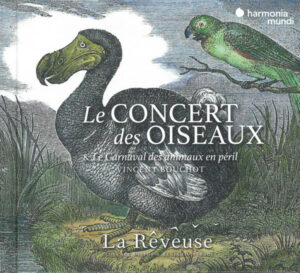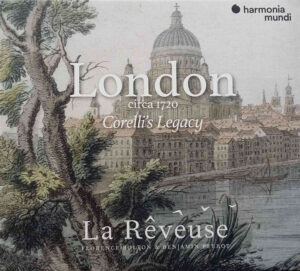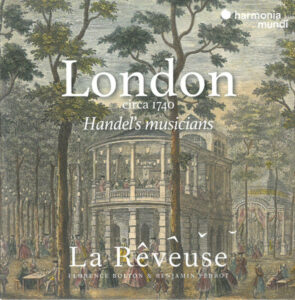Program: #23-47 Air Date: Nov 20, 2023
To listen to this show, you must first LOG IN. If you have already logged in, but you are still seeing this message, please SUBSCRIBE or UPGRADE your subscriber level today.
This wonderful Baroque ensemble gives us a new of birds in music, and two in their ongoing study of the English 18th century: London c. 1720 (“Corelli’s Legacy”) and London c. 1740 (“Handel’s Musicians”).
NOTE: All of the music on this program comes from the ensemble La Rêveuse directed by Florence Bolton and Benjamin Perrot.. The record on the Harmonia Mundi label. For more information:
I. Le Concert des Oiseaux. (HMM 902709)

From BBC Classical Music: An ornithological and zoological adventure awaits listeners here. The first 13 tracks present bird-related repertoire spanning the 17th and 21st centuries, ingeniously arranged for various types of flageolets, recorders, viols with theorbo, baroque guitar and harpsichord. Music by Britten, François Couperin, Henry Purcell, Rameau, Ravel and Saint-Saëns is heard alongside less familiar 16th- and 17th-century works, among which de Montéclair’s procession of various birds from his fifth concerto for two recorders is brought to vivid life on sixth flute (a type of recorder) and flageolet. The vibrant timbral blend of Baroque musette, recorder, bass viol and theorbo captures the humour of Michel Corrette’s cuckoo. Here, and some of the other tracks, pre-recorded bird sounds create a welcome aura of sonic authenticity. Finally, a nine-movement suite from Vincent Bouchot’s Le Carnaval des animaux en péril (2022). This musical and ecological fable, conceived as a stage work with visual projection and narration, draws attention to the accelerating disappearance of animal species. Bouchot’s addition of percussion to the instrumental mix is masterful, for example in depictions of the crocodile-like gharial and the sea cucumber. Lavish notes include captivating colour reproductions from works of art and detailed information about the cornucopia of musical instruments heard. In all, a fine testament to both the eclectic timbral diversity of earlier instruments and the versatility of La Rêveuse.
Ingrid Pearson
- Purcell: Prelude to Birds from "Fairy Queen"
- Van Eyck: England's Nightingale — from "The Flute Paradise"
- Theodor Schwarzkopf: Sonata in imitation of Nightingale and Cuckoo: Allegro/Gigue
- F. Couperin / La Revouse: Nightingale in Love — from "Clavesin Songs Volume 3"
- Jean-Baptiste Bousset/La Réveuse ed.: Why, sweet nightingale — from "Ale Volume 14"
- Monteclaire: Chirping — Concert No. 5 for 2 flutes
- F. Couperin/La Réveuse ed.: Lamenting Bunting — from "Clavesin Songs Volume 3"
- Colette: Cuckoo
- Saint-Saens/Vincent Bouchot: Cuckoo in the depths of the forest - from "Carnival of the Animals"
- Britten/Vincent Bouchot Arr.: Cuckoo from "Friday Afternoon"
- Rameau/Vincent Bouchot: Hens
- Saint-Saëns/Vincent Bouchot: Hens and Roosters from "Carnival of the Animals"
- Ravel/Vincent Bouchot: The Queen's Pottery Doll Redronet — From "Ma Mère Roi"
- Vincent Bouchot: Carnival of Endangered Species
- Prelude: Sorrow of the Pangolin
- Armando: Javanese Slow Loris
- Courant: old poultry dodo
- Intermezzo: Lesomira 63
- Sarabande: white and black owls
- Gavotte: Indian gharial (crocodile)
- Intermezzo: Lesomira 92
- Varus Twist: Sea Cucumber
- Jeeg: Mankind, its evolution
II. London ca. 1720: Corelli’s Legacy (HMM 905322)

From The Classical Review: This is La Rêveuse’s second in a series that explores music around London in the 1700s, a time they aptly mention as “rich in artistic experiments and inventions.” As in their well-received first installment (‘London Circa 1700’, featuring works by Purcell and his contemporaries), we get an illuminating view of the Baroque era, but this time into aspects of Arcangelo Corelli’s influence on the Concerto Grosso genre, among others. William Babell (1690–1723) was known as a successful harpsichordist and arranger. His original compositions, such as Concerto No. 2 for Sixth Flute (tracks 1–3) also show us his skill in ensemble writing. La Reveuse takes a well-balanced approach to this piece. The harpsichord accompaniment lets the string and wind soloists shine but also adds depth in the slower moments and rhythmic drive in the faster ones. In the opening movement, I noted the beautiful playing from the violins; a transparent tone in the single and double passages gives the opening movement its finesse. The second movement marks the arrival of the sixth flute. Although it is naturally a little more piercing than the violins, the soloist does well in toning down the instrument’s sonic edge to align with the strings’ sensitivities. The final movement is where the flute really brings out Babell’s virtuosic and elegant style. The soloist integrates a crystalline tone in the overall fluidity of the lines; the small turns and trills are clean and also add a delightful crispness (certainly doing justice to the composer himself, who was renowned for his mastery in extemporaneous ornamentation).
The homage to Corelli would not be complete without Johann Schickhardt’s Sonata IV Op. 6 (tracks 8–11), an arrangement based on two of Corelli’s Op. 6 Concerti Grossi. This is a thoughtful performance with much attention paid to details: the synchronicity of the winds throughout is faultless and delicately calibrated: the lower line gives body and dimensionality to the melody. (As an interesting reference, Corelli’s original version features strings rather than winds in the first movement’s opening — while the sound is fuller and denser, the wind version has an airy translucence). The performers also approach the alternating tempos in this movement sensibly. I found the handoff between the lyrical slow sections and the animated ones smooth and cohesive. Like most of the selections on the album, there is a pristine clarity not just from the soloists but across the ensemble. In the second movement, for example, there are distinctly perceptible layers of sound from and within the winds, strings, and harpsichord; even in the accompanimental keyboard part, we can still hear each well-executed ornament.
La Rêveuse also includes arrangements of famous vocal works of the time. ‘Spera, sì, mio caro bene (track 24) from Handel’s Admeto was transcribed in the 1730s (most likely by bassoonist Pietro Chaboud) for flute and small chamber orchestra — a reflection of the growing popularity to downside the vocal genre into a domestic setting. The ensemble reflects this historical context by incorporating subtleties in dynamics that would indeed be effective in an intimate space. The ritornellos bring out a warm sound quality, and the clear baselines play an integral role in adding textural complexity. The episodes between the ritornellos go beyond a focus on the soloist: we hear a vivid partnership between the wind and strings (2:10–2:23) that enables us to appreciate the counterpoint.
The liner notes are helpful but somewhat limited: there’s a lengthy discussion of the historical context of the program but less in-depth information on each composition, which will disappoint some curious listeners. The performance itself, though, is worth a dedicated listen. Warmly recommended.
WILLIAM BABELL
Concerto II Op. 3 for sixth flute D major / Ré majeur
(London, 1730, John Walsh)
- I. Adagio — Allegro (2'11)
- II. Adagio (3'02)
- III. Allegro (3'13)
FRANCESCO GEMINIANI
Sonata IV op. 1, H. 4
D major / Ré majeur
(London, 1716 / London 1718, Richard Meares / London, 1719, John Walsh / Amsterdam, 1719, Jeanne Roger)
Adagio
- I. Adagio (1'47)
- II. Allegro (2'30)
- III. Grave (1'07)
- IV. Allegro (1'41)
ARCANGELO CORELLI [1653–1713]
Sonata IV op. 6 after / d'après les Concerti grossi nos. 1 & 2 op. 6
F major / Fa majeur
(Amsterdam, 1719, Jeanne Roger / Londres, 1720, John Walsh)
- I. Largo — Allegro — Adagio — Allegro — Adagio — Allegro — Adagio (2'28)
- II. Allegro (1'52)
- III. Grave — Andante Largo (2'05)
- IV. Allegro (2'11)
GEORGE FRIDERIC HANDEL [1685–1759]
Concerto a quattro
D minor / Ré mineur
(c. 1715, Collection Graf von Schönborn — Wisentheid / Universitäts — und Landesbibliothek Darmstadt — Mus. ms 1042/45)
- I. Adagio (2'13)
- II. Allegro (1'41)
- III. Largo (1'36)
- IV. Allegro (2'03)
JOHANN CHRISTIAN SCHICKHARDT
Concerto II op. 19 for 2 recorders, 2 traversos [orig. 4 recorders] and basso continuo
Transp. to A minor / La mineur
(Amsterdam, nd, 1712-15 Etienne Roger & Michel Charles Le Cene)
- I. Allegro (2'13)
- II. Adagio (4'02)
- III. Vivace (1'39)
- IV. Allegro (1'59)
GEORGE FRIDERIC HANDEL [1685–1759]
Sonata per la viola da gamba HWV 364b
G minor / Sol mineur
(Londres c. 1730, John Walsh. Cambridge, Fitzwilliam Museum, Mu. MS 261)
- I. Andante larghetto (2'04)
- II. Allegro (1'58)
- III. Adagio (0'47)
- IV. Allegro (2'19)
- Spera si mio caro bene
Aria in B minor, arr. from Admeto HWV 22, opera, 1727
(Handel's Select aires or Sonatas [.], collected from all the late Operas. Londres, nd, 1738 ou 1743, John Walsh) (7'15)
NICOLA FRANCESCO HAYM
Nicola Francesco Haym (1678–1729) arr. Pietro Chaboud (fl.1707–25)
Thus with thirst my souls expiring
Aria in A minor, adaptation for the London stage from Il Pirro e Demetrioby Alessandro Scarlatti
(Aires & Symphonys, Londres, c. 1710, John Walsh) (5'00)
III. London ca. 1740: Handel’s musicians (HMM 902613)

The ensemble La Rêveuse, directed by Florence Bolton and Benjamin Perrot, has returned to 18th century London for another disc exploring British music of the 18th century.
London, ca.1740: Handel's musicians on Harmonia Mundi features sonatas and concertos from the 1740s with an emphasis on musicians who worked with Handel including Charles Weideman, Giuseppe Sammartini, and Pietro Castrucci, plus the Scottish musician James Oswald.
From Planet Hugill: Since the late 17th century, London had been a magnet for foreign musicians because money was to be made. The capital's lively musical life attracted all manner of Continental musicians and Handel's orchestra featured some of the best known virtuosos. Many were composers in their own right, so we have works from people who knew and worked with Handel. Some of the music on the disc was written for publication, some for private performances whilst others may well have been performed as part of the entertainments at Vauxhall Gardens where the Summer season provided music whilst the opera was closed.
The disc begins with a lovely, galant concerto for German flute (traverso) by Charles Weideman. Born Carl Friedrich Weidemann, he was a flautist and composer who joined Handel's orchestra in 1725. His Concerto VI Op.2 in E minorcomes from Six Concertos in Seven Parts published in 1746 by John Walsh (Handel's publisher). Three movements, slow, fast, slow, the work is compact and elegant, redolent of the drawing room with just enough showy material for our soloist.
The group follow this with Handel's Trio Sonata V Op. 2 in G minor from John Walsh's 1733 publication of Handel sonatas. With this sonata we are on more familiar territory, yet the performance never feels hackneyed and I enjoyed the richly textured feel to much of the music and expressive nature of the playing.
Giuseppi Sammartini arrived in London in the 1720s. A talented oboist, flute and recorder player, he was a noted virtuoso and became principal oboe in Handel's orchestra. His Concerto a piu Istromenti per la Fluta in F major is for the recorder, written at a time when the instrument was more of curiosity than anything else, though Handel would use it for particular effects in arias. The recorder concerto certainly brings a smile to the face, and Sébastien Marq is definitely a stylishly deft player. In three movements, fast, slow, fast, the middle one is a charming Siciliano.
With Pietro Castrucci's Sonata for viola da gamba in G minor we reach another instrument that was moving to curiosity status, though it retained a streak of popularity with amateurs and in Carl Friedrich Abel would have one of its last major virtuosos in London after Handel's death. Castrucci met Handel in Rome and Castrucci followed Handel to London in 1715 and he led Handel's orchestra for some twenty years. He eventually moved away from the world of opera and, after a difficult few years, moved to Dublin in 1750 in the hope of finding a better life there. But he failed to establish himself and died in poverty two years later. Known for his irritable character, he was probably the model for William Hogarth’s famous engraving The Enraged Musician.
Certainly the gamba concerto shows the instrument of to fine effect, and Florence Bolton plays with lovely mellow tone. None of the three movements are exactly slow, it moves from an Affetuoso which is certainly not slow, to Allegroand then a perky Giga, but each is full of character.
We move to a different set of influences and visitors with music from James Oswald, The Caledonian Pocket Companion, first published in London between 1745 to 1765 and A Curious Collection of Scots Tunes, published in 1740 in Edinburgh. It was Oswald who made his name taking Scottish melodies and turning them into polite drawing-room music with fiddle and lute making way for violin and German flute. A Curious Collection of Scots Tunes includes A Sonata of Scots Tunes, a trio sonata with movements based on five Scots tunes. This is real charmer, with La Rêveuse giving us some wonderfully rich instrumental textures, firmly moving these tunes into the drawing room. But it was with The Caledonian Pocket Companion that Oswald made his money and reputation. There is no link to Handel here, but it is a sample of the other influences passing through the drawing room.
This is a delightful and eclectic disc, drawing on a range of influences and composers to give us a suggestion of the musical life in London in the 1740s when musicians in Handel's orchestra could be star names in their own right. The performances from La Rêveuse are anything but polite and academic. Here we have a group of musicians giving us wonderfully engaged performances, full of style and all played with a great chamber music sensitivity.
- Charles Weideman (c.1705–1782) — Concerto VI Op. 2 for German Flute (traverso) E minor
- George Frideric Handel (1685–1759) — Trio sonata V op. 2 HWV 390 G minor
- Giuseppe Sammartini (1695–1750) — Concerto a piu Istromenti per la Fluta GSM 1711 F major
- Pietro Castrucci (1679–1752) — Sonata for viola da gamba G minor
- James Oswald (1710–1759) — The Caledonian Pocket Companion: Hugar Mu Fean, Sleepy Maggy
- James Oswald — A Sonata of Scots Tunes D major
- James Oswald — The Caledonian Pocket Companion: The Cameronian's Rant, Up in the Morning Early
- George Frideric Handel — Hornpipe Compos'd for the Concert at Vauxhall HWV 356
